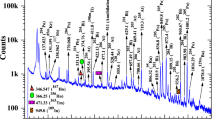Abstract
Light charged particle (LCP) emission in the evaporation residue (ER) and fusion fission (FF) channels have been studied for the 200 MeV 32S + 100Mo reaction, leading to 132Ce composite nuclei at E x =122 MeV. The main goal was to study the decay of 132 Ce on the basis of an extended set of observables, to get insights on the fission dynamics. The proton and alpha particle energy spectra, their multiplicities, ER-LCP angular correlations, ER and FF angular distributions, and ER and FF cross-sections were measured. The measured observables were compared with the Statistical Model (SM). Using standard parameters, the model was able to reproduce only the pre-scission multiplicities and the FF and ER cross-sections. The calculation was observed to strongly overestimate the proton and alpha particle multiplicities in the ER channel. Disagreements were also observed for the ER-LCP correlations, the LCP energy spectra and the ER angular distribution. By varying the SM input parameters over a wide range of values, it is shown that it is not possible to reproduce all the observables simultaneously with a unique set of parameters. The inadequacy of the model in reproducing the ER particle multiplicities is also observed analysing data from the literature for other systems in the A ≈ 150 and E x ≈ 100−200 MeV region. These results indicate serious limitations about the use of the SM in extracting information on fission dynamics.
Similar content being viewed by others
References
P. Paul, M. Thoennesen, Annu. Rev. Nucl. Part. Sci. 44, 65 (1994).
J.P. Lestone, Phys. Rev. C 59, 1549 (1999).
A. Chatterjee et al., Phys. Rev. C 52, 3167 (1995).
D.J. Hofman, B.B. Back, P. Paul, Nucl. Phys. A 599, 23c (1996).
L. Fiore et al., Nucl. Phys. A 620, 71 (1997).
V.A. Rubchenya et al., Phys. Rev. C 58, 1587 (1998).
E. Vardaci , in Proceedings of the International Symposium on Dynamics Aspects of Nuclear Fission, Casta-Papiernicka, Slovak Republic, October 1998, edited by Yu.Ts. Oganessian, J. Kliman and S. Gmuca (World Scientific, Singapore, 2000) p. 261
I. Diószegi et al., Phys. Rev. C 61, 024613 (2000).
I. Diószegi et al., Phys. Rev. C 63, 014611 (2000).
N.P. Shaw et al., Phys. Rev. C 61, 044612 (2000).
A. Saxena et al., Phys. Rev. C 65, 064601 (2002).
G. La Rana et al., Eur. Phys. J. A 16, 199 (2003).
M. Thoennessen, G.F. Bertsch, Phys. Rev. Lett. 71, 4303 (1993).
E. Vardaci et al., Eur. Phys. J. A 43, 127 (2010).
E. Fioretto et al., IEEE Trans. Nucl. Sci. 44, 1017 (1997).
J.F. Ziegler, J.P. Biersack, U. Littmark, Stopping and Range of Ions in Solids (Pergamon Press, New York, 1985).
A. Ordine, A. Boiano, E. Vardaci, A. Zaghi, A. Brondi, IEEE Trans. Nucl. Sci. 45, 873 (1998).
E. Vardaci, VISM: a Computer Program for Nuclear Data Analysis, Annual Report Carnegie Mellon University, Pittsburgh, USA, 1989
S. Beghini et al., Nucl. Instrum. Methods Phys. Res. A 239, 585 (1985).
E.M. Kozulin et al., Instrum. Exp. Tech. 51, 44 (2008).
J.R. Huizenga, A.N. Behkami, L.G. Moretto, Phys. Rev. 177, 1826 (1969).
Lilita program was written by J. Gomez del Campo and R.G. Stockstad, Oak Ridge National Laboratory Report No. TM7295, 1981 (unpublished).
A. Gavron, Phys. Rev. C 21, 230 (1980).
N.N. Ajitanand, R. Lacey, G.F. Peaslee, E. Duek, J.M. Alexander, Nucl. Instrum. Methods Phys. Res. A 243, 111 (1986) and references therein
J.R. Huizenga, G. Igo, Nucl. Phys. 29, 462 (1961).
F.G. Perey, Phys. Rev. 131, 745 (1963).
D. Willmore, P.E. Hudson, Nucl. Phys. 55, 673 (1964).
L.C. Vaz et al., Z. Phys. A 318, 231 (1984).
A.J. Sierk, Phys. Rev. C 33, 2039 (1986).
A. Gilbert, A.G.W. Cameron, Can. J. Phys. 43, 1446 (1965).
N. Bohr, J.A. Wheeler, Phys. Rev. 56, 426 (1939).
V.E. Viola et al., Phys. Rev. C 31, 1550 (1985).
N.N. Ajitanand et al., Phys. Rev. C 34, 877 (1986).
R. Lacey et al., Phys. Rev. C 37, 2540 (1988).
W.E. Parker et al., Nucl. Phys. A 568, 633 (1994).
E. Duek et al., Phys. Lett. B 131, 297 (1983).
L. Schad et al., Z. Phys. A 318, 179 (1984).
E. Vardaci et al., Phys. Lett. B 480, 239 (2000).
S.K. Kataria, V.S. Ramamurthy, S.S. Kapoor, Phys. Rev. C 18, 549 (1978).
A.V. Ignatyuk et al., Sov. J. Nucl. Phys. 21, 612 (1975).
J.P. Lestone, Phys. Rev. C 52, 1118 (1995).
R.J. Charity, Computer code GEMINI (unpublished).
M. Gonin et al., Phys. Lett. B 217, 406 (1989).
J.M. Alexander , Proceedings of the Symposium on Nuclear Dynamical and Nuclear Disassembly, 1988, Dallas, Texas, USA, edited by J.B. Natowitz (World Scientific, Singapore, 1989) p. 211
J.L. Wile et al., Phys. Rev. C 51, 1693 (1995).
Author information
Authors and Affiliations
Corresponding author
Additional information
Communicated by C. Signorini
Rights and permissions
About this article
Cite this article
Di Nitto, A., Vardaci, E., Brondi, A. et al. Evaporation and fission decay of 132Ce compound nuclei at Ex=122 MeV: some limitations of the statistical model. Eur. Phys. J. A 47, 83 (2011). https://doi.org/10.1140/epja/i2011-11083-6
Received:
Revised:
Accepted:
Published:
DOI: https://doi.org/10.1140/epja/i2011-11083-6



